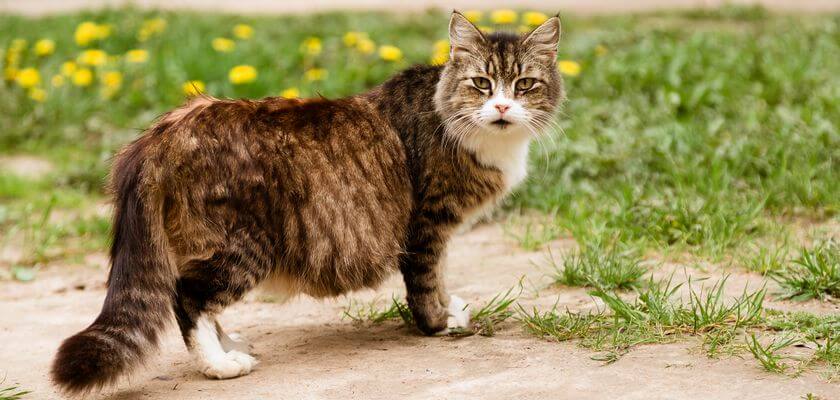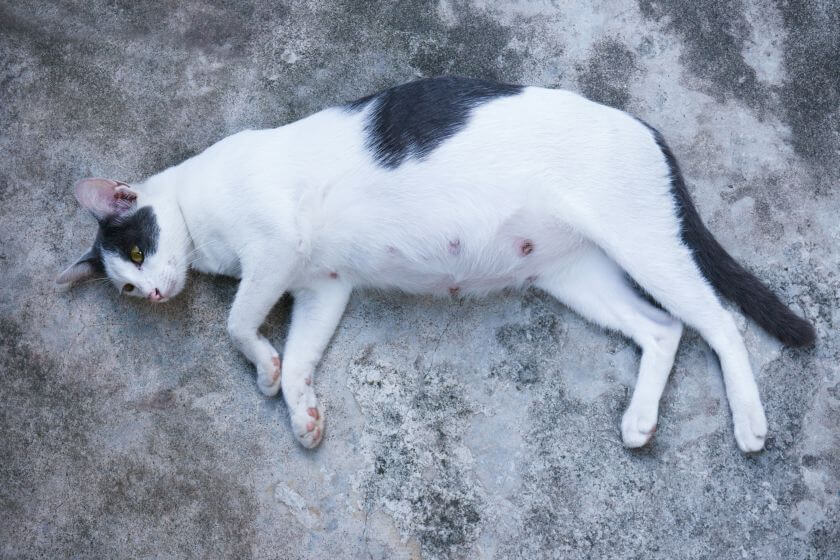If your cat is not neutered and she freely goes outside, sooner or later you can expect pregnancy. It is also possible that one day a cat will come under your roof and you will suspect it of a different condition. In such cases, it is worth knowing what symptoms may indicate pregnancy and how to take good care of your cat before and during birth. Below you will find all the information you need.
How to recognize a pregnant cat?
Most of us have wondered at least once in their lives whether the cat we meet on the street is expecting young or simply fat. The symptoms of pregnancy in a female cat may vary depending on the trimester and individual characteristics.
Changes in a cat’s body appear fairly quickly. As early as two weeks after fertilization, the nipples change color and become larger. The cat’s appetite may increase, although she may experience vomiting and nausea. If you can touch the animal’s belly, you can easily distinguish pregnancy from normal obesity. The fetuses are palpable. They are in the form of round pouches that can be felt under the abdominal wall.
During pregnancy, the cat’s behavior also changes. In general, she is more lethargic, more calm and sleeps much more. Changes in a kitten’s personality vary greatly. Sometimes animals that are quite distant on a daily basis become very sensitive during pregnancy and seek contact with humans. A very sociable cat, on the other hand, can spend time alone and not be tempted to caress.
How long does a cat get pregnant?
How long does a cat get pregnant? Childbirth is usually 66 days after conception. In theory, however, pregnancy can last anywhere from 52 to 74 days.

In the first weeks, the changes are very delicate and practically invisible to people who do not know their pet very well. Fetuses begin to grow very rapidly four weeks after conception. Hormonal changes take place in the body of the expectant mother.
The number of fetuses can only be precisely determined by a veterinarian on the basis of an ultrasound examination. They can be performed in the sixth week of pregnancy.
Pregnant cat – how to care for it?
A pregnant female cat deserves special care and very responsible treatment. Although a cat’s pregnancy is not a disease, it carries a risk of complications. In order to minimize them, it is worth limiting your cat’s potential causes of stress. Cats are animals that are extremely vulnerable to it. A large number of stressful situations can negatively affect their immune system. So remember to limit your changes and stick to your routine as much as possible.
From the seventh week of pregnancy, a kitten can look for a place where it will build a nest for childbirth. It may be a good idea to provide her with a warm and calm shelter where she can hide from the view of the public.
Typically, pregnant cats are calmer, but some of them may still be prone to climbing and high jumping. During pregnancy, remove tall scratchers from home and restrict your cat’s access to high places. Excessive activity can result in a hernia.
Pregnant cat – diet
A cat’s pregnancy is a period in which the body’s energy requirements increase. A cat’s diet should therefore be very well-balanced and rich in minerals and vitamins. Avoid dry food and food that contains a large amount of plant products. You will find good quality animal protein in high-meat wet foods.
Do not take any supplementation without consulting your veterinarian or dietician.
Pregnant cat – research
A pregnant female cat should be under the constant care of a veterinarian. The tests that are worth considering include, above all, ultrasound and X-ray. An ultrasound scan will be able to determine if a pregnancy is actually taking place and if the fetuses are alive. X-rays, on the other hand, may answer the question of exactly how many cats are in the womb. It is best to do them six weeks after fertilization.
Cat pregnancy – what you need to know about childbirth?
A kitten may start looking for a place for childbirth already in the fifth week of pregnancy. The search intensity increases significantly in the seventh week. You can prepare a quiet place for her, but you should take into account that she will probably find a nest that will suit her needs better. It could be the inside of your wardrobe or an abandoned cardboard box.
It is helpful to know how long your cat is pregnant in order to calculate when the termination will occur. Symptoms that herald childbirth are:
- anxiety;
- circulation from place to place;
- licking the perineal area;
- leakage of milk from the nipples.
Unlike a cat’s pregnancy, giving birth usually does not require any intervention on your part. There may be times when you don’t even notice the action. However, keep in mind that in some situations there may be complications that are not uncommon at all. If you see that the birthing process has been going on for more than an hour and no kitten has been born yet, you should take your kitten to the vet quickly.
The birthing operation is very painful and carries the risk of complications. Before delivery, it is recommended that at least one X-ray is performed to determine how many fetuses there are in the womb. Then you will know if any of the kittens get stuck in the birth canal. Such a situation requires very quick surgical intervention, otherwise it ends in the kitten’s death.
Usually three to six kittens are born in a litter. There may be more, but you must know that sometimes only one toddler is born. Paradoxically, such litters are more prone to complications. Fetal movements provoke labor, a single kitten is less mobile, so pregnancies are often transferred.
Cat pregnancy – how to prevent it?
You should be aware that – if you do not run a registered kennel – you should not allow new kittens to appear in the world. There is still a misconception that a kitten should give birth at least once, then she will be healthier and happier. Nothing could be more wrong.
Cats do not feel the maternal instinct until delivery triggers the production of certain hormones in their bodies. They are unaware of motherhood and will never regret the lack of it in any way – a cat’s pregnancy is not his goal in life. By designing human emotions for animals, we do a lot of harm to animals in the best of our faith. Cat breeding outside catteries leads to:
- increasing homelessness;
- risk of complications;
- body loads;
- pain associated with childbirth, and even with fertilization itself (there are spikes on the male’s penis, which cause severe pain to the female during copulation).
It is worth knowing not only how long a cat’s pregnancy lasts, but also how to prevent it. When a kitten arrives at your home, arrange for her to be castrated. It is a simple and routine operation that deprives your animal of reproductive capacity once and for all. It also has a very good effect on his health. Kittens can be successfully neutered even when they are three to four months old. It is not worth waiting until the first estrus before it is done.
In some cases, you may also consider abortion castration. While controversial for many people, it ultimately has a positive effect on the female cat and reduces homelessness.Pregnancy in a cat is a special period during which the expectant mother needs special care. However, the best thing you can do for your kitten is to avoid fertilization. Ask your nearest veterinarian about castration. Many municipalities offer co-financing of its costs.

